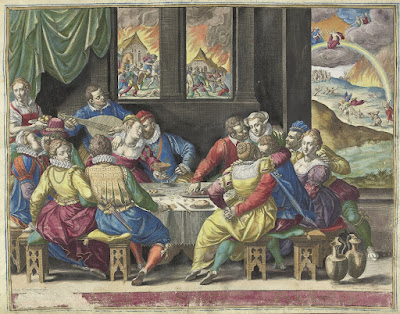 |
| Monogrammist A.I. The Rich Man and Death 1553 hand-colored woodcut and letterpress Rijksmuseum, Amsterdam |
 |
| Jan Sadeler the Elder after Dirck Barendsz Mankind awaiting the Last Judgment ca. 1581-83 hand-colored engraving Rijksmuseum, Amsterdam |
 |
| Monogrammist D.V.H. Two Lame Couples Dancing 16th century engraving Kupferstich-Kabinett, Gemäldegalerie, Dresden |
 |
| Andrea Andreani after Giambologna Abduction of the Sabine Women before 1623 chiaroscuro woodcut, assembled from multiple panels Rijksmuseum, Amsterdam |
 |
| Giuseppe Caletti (il Cremonese) Beheading of St John the Baptist ca. 1620-30 etching Metropolitan Museum of Art, New York |
 |
| Christoffel Jegher after Peter Paul Rubens Hercules Triumphant over Discord ca. 1633-34 woodcut Minneapolis Institute of Art |
 |
| Salvator Rosa Combat of Tritons 1660-61 etching Milwaukee Art Museum |
 |
| Sébastien Bourdon Freeing the Captive (from the series, Seven Acts of Mercy) ca. 1660-70 etching Milwaukee Art Museum |
 |
| Gérard de Lairesse Mercury with the Head of Argus ca. 1670-72 etching Teylers Museum, Haarlem |
 |
| Joseph Van Loo after Peter Paul Rubens Mercury and Jupiter served by Baucis and Philemon before 1740 engraving Teylers Museum, Haarlem |
 |
| Richard Earlom after Andrea Sacchi The Death of Abel 1766 etching Minneapolis Institute of Art |
 |
| Isidore Stanislas Helman after Nicolas Lavreince The Dangerous Novel 1781 etching Art Institute of Chicago |
 |
| William Dent Grand and Effectual Attack in the Baltic 1791 hand-colored etching Yale Center for British Art |
 |
| James Barry Milton dictating to Ellwood the Quaker ca. 1804-1805 etching, engraving and aquatint Art Institute of Chicago |
 |
| James Gillray Phaeton Alarmed! (George Canning facing political opponents) 1808 hand-colored etching Morgan Library, New York |
 |
| Anonymous German Artist Napoleon in disguise on his way into exile on Elba in 1814 ca. 1820 hand-colored etching Philadelphia Museum of Art |
Around four in the morning on 6 May 1527, an Imperial army under the command of Charles of Bourbon began its attack on the city of Rome. His armor draped in a white coat for visibility, Bourbon circulated among his men – mostly Spanish and German Imperial troops, augmented with some French and Italian soldiers – urging them onward. At first they directed their attack against the city walls that enclosed the Vatican and the Borgo districts on the west side of the Tiber River, concentrating their efforts upon a low point in the south wall near the Porta San Spirito. The defenders repelled the initial assaults, but within an hour an unusually dense fog rolled in, rendering useless the cannons of the nearby papal fortress, the Castel Sant' Angelo. Early in the fighting, an arquebus shot mortally wounded the Duke of Bourbon as he was urging his men to scale the walls at the Porta Torrione. But his troops persevered, and around six a.m. they breached the defences in three places just as the fog – which many would interpret as divinely sent – began to lift.
There followed an immediate breakdown of discipline among the defenders. Most sought to flee either by bridge or by boat across the Tiber to the intact center of the city. Renzo da Ceri, the commander who had been responsible for organizing the Romans' defense, responded to the incursion with mingled bewilderment and terror, and he himself ultimately fled into the papal fortress. When Pope Clement VII, at prayer in his private chapel in the Vatican, heard the commotion of the approaching troops, he and several others – including the humanist Paolo Giovio and the Cardinal Alessandro Farnese (the future Pope Paul III) – fled along the Alexandrine corridor to the Castel Sant' Angelo. From its confines, crowded with around a thousand refugees*, the pontiff could look out upon the destruction below, helpless to halt it.
Next, the Imperialists set upon Trastavere, the district lying to the south of the Vatican on the west side of the Tiber. Soon they broke through the defenses at the Porta Settimiana and continued their conquest. That evening they made their way across the Ponte Sisto and into the central districts of Rome, shouting triumphantly as they went. The disoriented populace offered little resistance, and by the following morning, with the exception of the Castel Sant' Angelo and a handful of private palaces, all Rome had fallen to the Imperialists.
Thereafter, the plight of the Roman only became more desperate. The death of Bourbon had left the contingents of the Imperial army without a common commander who could put a stop to the sacking of the city. If out of righteous zeal German Lutheran troops desecrated relics, Spanish Catholic soldiers proved no less eager to strip precious metals and stones from the statues and tombs of saints and of popes. Even the German and Spanish churches in Rome did not escape the plundering. Often Romans were captured, tortured, and ransomed by one contingent of soldiers only to endure similar treatment from another. Those who lacked the resources to pay at once might be killed on the spot, or else enslaved until a ransom could be extorted from their relatives.
– Kenneth Gouwens, from Remembering the Renaissance: Humanist Narratives of the Sack of Rome (Brill, 1998)
*André Chastel's 1983 volume on the Sack numbers those taking refuge on May 6 inside Castel Sant' Angelo at "nearly three thousand" – (Chastel's scholarship, on the whole, encouraging more confidence than that of Gouwens).